WHAT'S NEW ACROSS THE WORLD
Select date in side bar to go a What's
New of previous issues
| What's New ©by
Laif DeMason
Summer is finally here and the continuing rising
energy costs has had an effect on everyone. Since fuel is necessary for
the collecting and shipping of tropical fish, the landed costs have increased
considerably since last year at this time. Importers are no longer willing
to absorb the extra fuel charges levied by the airlines and thus prices
of most imported fishes are noticeably higher. Many importers are
turning to buying from countries that are closer and thus cheaper in freight
expenses, dropping the suppliers in higher freight places in other parts
of the world. One can only wonder how much higher will prices go!
Here’s “what’s new” on the cichlid scene: |
Lake Tanganyika
Exports from Lake Tanganyika continue to flow, although it seems like
no one is working overtime. Collections from the southern Congo coasts
by Zambians have slowed considerably due to high fuel prices and long distance
motoring by boat. However, exports from Burundi have started to include
more wild items from the nearby northern sections of Congo. Stay tuned
to see what will develop!
|
what's new: Lake Tanganyika
|
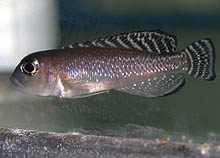
Exported from Burundi, Lamprologus ornatipinnis
is available. In the past, this species was mostly shipped from Zambia.
This northern form has nice markings and appears to be bigger than its
southern counterparts. |
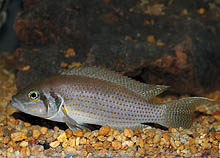
Also collected and exported from Zambia, Neolamprologus
pulcher has appeared again. This fish is from Chituta, with the well
defined facial “double chevron” markings and the red-brown body flecks. |
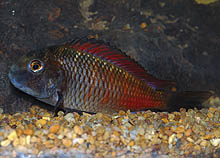
Collected in Katete, Zambia this Tropheus moorii
is very similar to the Chipimbi (firecracker) type, though the Katete version
seems to have a broader red stripe near its caudal peduncle. The extra
coloration makes this fish an interesting change for Tropheus fans. |
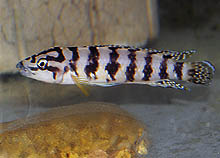
Generally only available from bred sources, Julidochromis
sp. ‘gombi transcriptus’ with the classical strong vertical barring and
contrasting markings is a real find. This form has not been exported for
many years for unknown reasons. |
Lake Malawi
Life goes on around Lake Malawi. Exports from the late Stuart Grant’s
facility have started again and continue. However, the exported species
selection has been reduced somewhat due to high fuel prices. Tanzanian
exports continue on, but also on a reduced level due to the slowing of
economies in import countries.
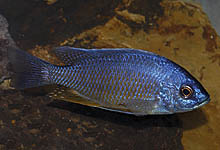
Collected only occasionally by season, Copadichromis
borleyi Undu (Tanzania) is a jumbo form with strong blue coloration.
Only few individuals are caught and exported each time. |
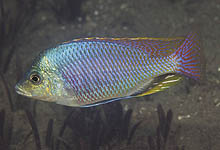
Collected in Likoma Island, Malawi, Protomelas
similis has arrived again. Once settled down, this fish can develop
strong and pleasing coloration. Photo by A. Konings. |

Metriaclima sp. ‘aurora bevous’ is a rarely
exported aurora type from Chizumulu Island. The beige and yellow colored
females have black stripes in the tail. Photo by A. Konings. |
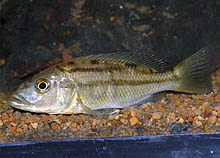
Often sent as Tyannochromis maculiceps Mbenji,
this fish is actually T. macrostoma. However, it is clearly colored
differently than the T. macrostoma that develops a black belly.
The maculiceps type rarely has a black belly. |
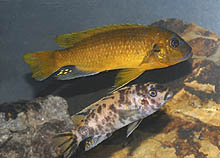
Not often seem from the lake, Metriclima sp.
‘zebra gold’ Lions Cove, Malawi, has the typical gold-yellow “mustardi”
color for the males, along with OB females. With special breeding efforts,
a rare yellow Marmalade Cat male can be isolated! |
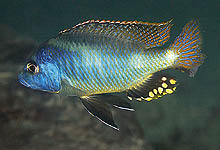
Found and exported in small number, Naevochromis
chrysogaster is trickling in again. Also nicknamed the Jack Dempsey
from Malawi, an interested aquarist would need to buy all fish available
a few different times to collect enough individuals to breed. Photo by
A. Konings. |
Lake Victoria
Wild caught collections from the Mwanza Gulf area of Lake Victoria can
only be called spotty at best. Logistical problems still plague the exporter
from obtaining enough material to justify collecting costs. Hopefully with
an increase in demand, more frequent collecting will occur. Victoria fans
can only hope for new and different fishes.
|
what's new: Lake Victoria
|
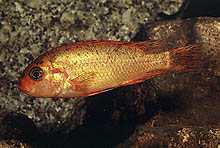
Exported earlier in the year, Neochromis omnicaeruleus
also comes in a “red OB” form. Thus we have seen three color forms of the
“blue scraper” from Tanzania recently. Photo by O. Seehausen. |
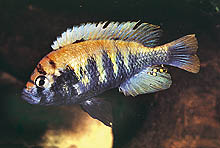
Also collected earlier in the year from Python Island,
Tanzania, wild caught Pundamilia nyererei has been imported for
the first time in decades. Only a few individuals from this location were
actually shipped. Photo by O. Seehausen. |
Neotropics
Some importers in the Untied States have begun to buy more South American
fishes and less African fishes due to the rising costs of freight from
long distances. Thus, imports from Brazil, Peru, and Columbia have increased
over the last year. Interestingly, avid hobbyists have often ventured into
the non-exporting countries, such as Bolivia and Uruguay, in search of
new items. So there is something for everyone!
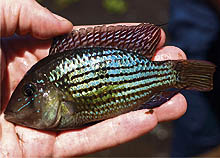
Collected in an area of Uruguay called Fayle Muerto,
this Gymnogeophagus rhabdotus sports metallic blue hues, but lacks
any yellow coloration typical for other gymnogeophagines from Uruguay.
Photo by S. Jack. |

Originally collected from Rio Cuareim, Uruguay, Crenicichla
cf. lepidota has been brought back to the USA for breeding. This is
one of five pike cichlid species from the same river, and one of the most
beautiful. Photo by S. Jack. |
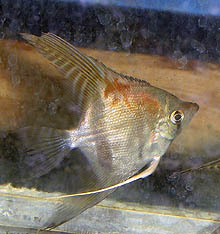
From Lago Manacapuru, Brazil, this wild caught Pterophyllum
cf. scalare displays an interesting reddish brown patch on its upper
body. Similarly colored angelfish have also been reported from Rio Negro
proper. Photo by J. Rapps. |
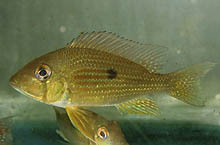
Geophagus taeniopareius is widespread in Venezuela,
including the upper Rio Orinoco. This substrate spawning eartheater is
a medium-sized species that generally will not exceed 5" to 6" in length.
Photo by J. Rapps. |
Select date in side bar to go a What's
New of previous issues
|















